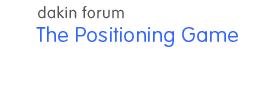|
Maximizing the Potential of Client
Meetings
Dana Dakin: Article in the Family Office Exchange
 
Meetings between clients and investment managers are an extension of the
investment process itself. Good meetings help clients to be better investors,
and they help managers to build long-term business relationships.
The goal of every meeting is to have a meaningful dialogue in order to
increase the client's understanding of your investment approach and stabilize
comfort. Ironically, the most effective way to accomplish this is to take
the opportunity when performance results are good to talk about the issues
that are concerning you and the steps you're taking to address them. This
gives you the credibility you need to discuss what's going right when
performance lags expectations.
Even the most sophisticated clients bring mixed feelings to a meeting.
The fear and greed intrinsic to all investing, and the uncertainty of
what the future will bring, generate intense emotions which are potentially
explosive. Recognizing this, it is important to establish a set of communications
procedures that will help you create meaningful dialogues with your clients
as well as help build understanding of your investment process.
Establishing a Foundation

In an ideal world, investment objectives would be defined and agreed upon
by the investment committee, formalized in a written statement of investment
policy, and discussed openly with the investment managers competing for
the account prior to hiring. But in an age of "beauty contests"
and "horse races," real clarity is all too infrequently achieved
at this juncture. So it is imperative that investment objectives be fully
understood by all parties and translated into a tracking format at the
outset. This one simple concept adds significantly to a "no surprises"
atmosphere and is the foundation for all communications over the course
of the entire relationship.
Developing an Agenda

The meeting agenda is another important communications tool in successful
client/manager relationships. It should be determined in collaboration
with the client. Agendas bring focus; they insure that presentations start
at a meaningful information point and cover what's important. Established
in advance, they also mitigate the "entertain" or "sell"
functions which can infiltrate client meetings. Lastly, they support the
"educate" and "exchange" functions which help keep
investment committees informed and comfortable. In the words of one consultant
"We're looking for a money manager who does more than pay lip service
to the concept of meeting with clients fairly regularly. An excellent
manager means somebody who, when he's having these meetings, is dealing
in a relevant way with his client. All too often I find somebody goes
on and on about where the economy is going and things like that. Also,
they often have a canned presentation rather than tailoring it to us.
What I would hope for is that they would explain their product, explain
their methods of operation and talk in clear, straightforward terms to
the people at hand.
The Education Imperative

It is important to review results over a meaningful period of time to
educate the client about what types of decisions were made, the reasons
for making them and how they contributed to overall performance. It is
then possible to move into discussing the logical framework for the current
portfolio positioning and expectations for future performance within different
scenarios.
A meeting is successful when clients can reinforce in their own minds
the logic of the decision-making process and connect to that process actual
performance results. The bottom line: Do they still feel good about hiring
you?
Good meeting procedures actually contribute to long-term performance,
because money managers are motivated to perform for strong clients who
exude a sense of partnership and fair play. Clients, on the other hand,
are motivated to stand behind managers who generate trust through consistent,
informative communications.
A Proposed Meeting Format

1. The Opening
- Establish the timeframe for the meeting and encourage questions and
discussions
2. The Past
- Address the investment outlook presented at the last meeting and compare
to actual results
- Review subsequent action and shifts in holdings
- Assess portfolio changes within the context of your investment philosophy:
- What worked
- What did not work and why
- What you did about it
3. Present absolute results for total holdings and appropriate portfolio
groupings:
- Relative to short-term expectations
- Relative to your long-term bogey
- Relative to the appropriate market indices
- Relative to the competition
- Show performance attribution:
- Which portion of the portfolio contributed to gains? Which to losses?
- How do performance results relate to your philosophy?
4. The Future
- Briefly review your investment outlook
- Show how your current portfolio is positioned to capitalize on that
outlook
- Summarize how you expect to continue to meet long-term objectives
- Introduce emerging ideas and information about your firm.
5. The Close
- Review the key points
- Solicit questions to assure client understanding and continued endorsement
- Thank the client for the meeting.
|



